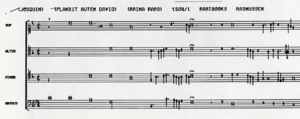Difference between revisions of "Fastcode"
| Line 3: | Line 3: | ||
<b>Fastcode</b>, developed at Princeton University by Tom Hall in the mid-1970s, was the first encoding system designed for mensural notation. It was specifically intended for use in a project led by [https://www.princeton.edu/pr/pwb/07/0402/2a.shtml Harry Powers] to encode music by [https://en.wikipedia.org/wiki/Orlande_de_Lassus Orlando de Lassus] and [https://en.wikipedia.org/wiki/Tielman_Susato Tielman Susato]. Its focus was therefore on sixteenth-century printed music. The fact that the input system was intended for keypunch dates is consistent with its development in the Seventies. | <b>Fastcode</b>, developed at Princeton University by Tom Hall in the mid-1970s, was the first encoding system designed for mensural notation. It was specifically intended for use in a project led by [https://www.princeton.edu/pr/pwb/07/0402/2a.shtml Harry Powers] to encode music by [https://en.wikipedia.org/wiki/Orlande_de_Lassus Orlando de Lassus] and [https://en.wikipedia.org/wiki/Tielman_Susato Tielman Susato]. Its focus was therefore on sixteenth-century printed music. The fact that the input system was intended for keypunch dates is consistent with its development in the Seventies. | ||
| − | [[File:Fastcode2.PNG| | + | [[File:Fastcode2.PNG|8 |
| + | 00px|thumb|center|<small>Fastcode output, Princeton University, of Josquin's "Planxit autem David". Music encoded from partbooks by Steven C. Rasmussen.</small>]] | ||
The most important part of the system is concerned with the reckoning of time values in mensural notation with those in modern notation. The music was preserved in part books. Susato developed the earliest moveable-type system in Antwerp. He was also a calligrapher, trumpeter, and flautist. He composed numerous dance pieces and masses. He was also the first publisher of the music of Lassus. Susato's system of music typography was soon adopted by [https://en.wikipedia.org/wiki/Pierre_Phal%C3%A8se_the_Elder Pierre Phalése] in Leuven. Phalése published works by [https://en.wikipedia.org/wiki/Adrian_Willaert Adriano Willaert] and a large number of chansons in the middle decades of the sixteenth century. | The most important part of the system is concerned with the reckoning of time values in mensural notation with those in modern notation. The music was preserved in part books. Susato developed the earliest moveable-type system in Antwerp. He was also a calligrapher, trumpeter, and flautist. He composed numerous dance pieces and masses. He was also the first publisher of the music of Lassus. Susato's system of music typography was soon adopted by [https://en.wikipedia.org/wiki/Pierre_Phal%C3%A8se_the_Elder Pierre Phalése] in Leuven. Phalése published works by [https://en.wikipedia.org/wiki/Adrian_Willaert Adriano Willaert] and a large number of chansons in the middle decades of the sixteenth century. | ||
Revision as of 22:45, 27 October 2022
Fastcode
Fastcode, developed at Princeton University by Tom Hall in the mid-1970s, was the first encoding system designed for mensural notation. It was specifically intended for use in a project led by Harry Powers to encode music by Orlando de Lassus and Tielman Susato. Its focus was therefore on sixteenth-century printed music. The fact that the input system was intended for keypunch dates is consistent with its development in the Seventies.
The most important part of the system is concerned with the reckoning of time values in mensural notation with those in modern notation. The music was preserved in part books. Susato developed the earliest moveable-type system in Antwerp. He was also a calligrapher, trumpeter, and flautist. He composed numerous dance pieces and masses. He was also the first publisher of the music of Lassus. Susato's system of music typography was soon adopted by Pierre Phalése in Leuven. Phalése published works by Adriano Willaert and a large number of chansons in the middle decades of the sixteenth century.
One of Fastcode's design strengths was its suitability to translation to other codes. Among these was DARMS, which Hall adapted and extended to the needs of A-R Editions. Hall's nearest peer in attempting the typesetting of mensural notation was Norbert Böker-Heil.
- Fastcode manual, 1981
Return to ADAM
